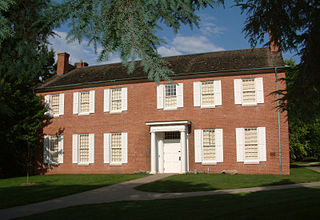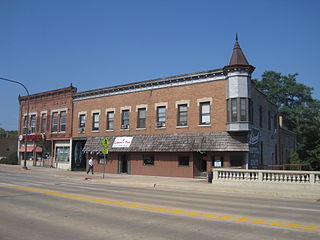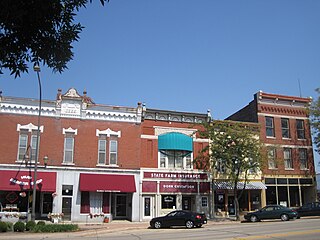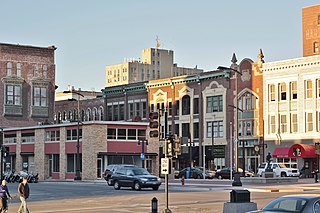
Illinois Institute of Technology is a private research university in Chicago, Illinois. Tracing its history to 1890, the present name was adopted upon the merger of the Armour Institute and Lewis Institute in 1940. The university has programs in architecture, business, communications, design, engineering, industrial technology, information technology, law, psychology, and science. It is classified among "R2: Doctoral Universities – High research activity".

Jacksonville is a city in Morgan County, Illinois, United States. The population was 19,446 at the 2010 census. It is the county seat of Morgan County. It is home to Illinois College, Illinois School for the Deaf, and the Illinois School for the Visually Impaired.

Prairie School is a late 19th- and early 20th-century architectural style, most common in the Midwestern United States. The style is usually marked by horizontal lines, flat or hipped roofs with broad overhanging eaves, windows grouped in horizontal bands, integration with the landscape, solid construction, craftsmanship, and discipline in the use of ornament. Horizontal lines were thought to evoke and relate to the wide, flat, treeless expanses of America's native prairie landscape.

The North State Street Historic District is a nationally designated historic district in Monticello, Piatt County, Illinois. The residential district is centered on State Street north of downtown Monticello; it includes 77 buildings, 56 of which are considered contributing to its historic character. The houses in the district represent the variety of architectural styles seen in Monticello from 1870 to 1948, the ages of the oldest and newest houses. The oldest houses in the district are designed in the Gothic Revival and Queen Anne styles. In the early 20th century, Monticello experienced an economic boom due to growth in agriculture and the local patent medicine industry; its newly wealthy residents built homes on State Street, which became known locally as "Millionaire's Row". The majority of these new homes had Colonial Revival designs, as the style was nationally popular at the time; Colonial Revival is still the district's predominant architectural style. Other designs featured in the district include Craftsman, Tudor Revival, and a Lustron house built in 1948. The district also includes several vernacular house types, such as the I-house and the bungalow.

The Frank Lloyd Wright/Prairie School of Architecture Historic District is a residential neighborhood in the Cook County, Illinois village of Oak Park, United States. The Frank Lloyd Wright Historic District is both a federally designated historic district listed on the U.S. National Register of Historic Places and a local historic district within the village of Oak Park. The districts have differing boundaries and contributing properties, over 20 of which were designed by Frank Lloyd Wright, widely regarded as the greatest American architect.

The Franklin School is a building designed by Adolf Cluss in the German round-arch style, located on Franklin Square at 13th and K Street in Washington, D.C. It was constructed in 1869 and initially served as a flagship school building. It later took on various other educational roles, and became a homeless shelter in the 2000s. In 2020, it became the location of the Planet Word museum.

The Gallaudet College Historic District is a National Historic Landmark District encompassing the historic early campus of Gallaudet University in Washington, D.C.. Gallaudet is the first school of higher education to be devoted to the education of the deaf and hard of hearing. Its campus was planned by Frederick Law Olmsted and Calvert Vaux, and its Gothic buildings were designed by Frederick Withers. The main Gallaudet College building was listed on the National Register of Historic Places in 1966 and designated a National Historic Landmark in 1965. The landmarked area was increased to cover the southern part of the campus, and was renamed as a historic district in 1974.

The North Carolina School for the Deaf is a state-supported residential school for deaf children established in 1894, in Morganton, North Carolina, US.

There are 69 properties listed on the National Register of Historic Places in Albany, New York, United States. Six are additionally designated as National Historic Landmarks (NHLs), the most of any city in the state after New York City. Another 14 are historic districts, for which 20 of the listings are also contributing properties. Two properties, both buildings, that had been listed in the past but have since been demolished have been delisted; one building that is also no longer extant remains listed.

The Masonic Temple Building is a historic Prairie-style building in Oak Park, Illinois, at the corner of Oak Park Avenue and Lake Street. It is in the Ridgeland-Oak Park Historic District and was individually listed on the National Register of Historic Places in 1982.

Beecher Hall is the oldest building on the campus of Illinois College in Jacksonville, Illinois. Built in 1829-30, it was the first college building erected in the state of Illinois. The building has served many functions for Illinois College, including housing the first medical school in Illinois in 1843. It is named after the first president of Illinois College, Edward Beecher. Beecher Hall is recognized by the National Park Service as being a stop on the Underground Railroad. The building is listed on the National Register of Historic Places.

Marcy Village Apartments is a historic community located in Indianapolis, Indiana, United States. Built in 1939, the 25-acre (10 ha), 19-building apartment community compose a historic district that was listed on the National Register of Historic Places on March 24, 2004. Ground for the development was broken the week of March 20, 1939, and work was started on a full-time basis with Everett A. Carson of Indianapolis as the builder. Architects, Granger & Bollenbacher of Chicago, created the Colonial Revival apartment community for owners at the time, Marcy Realty Corporation.

Riverside and Avondale are two adjacent and closely associated neighborhoods, alternatively considered one continuous neighborhood, of Jacksonville, Florida. The area is primarily residential, but includes some commercial districts, including Five Points, the King Street District, and the Shoppes of Avondale.

Joseph William Royer (1873–1954) was a prolific architect from Urbana, Illinois who designed many prominent buildings in Urbana, Champaign, and beyond. His work included civic, educational, commercial, and residential buildings, many of which are listed in the National Register of Historic Places and feature a wide variety of architectural styles.

The Morris Downtown Commercial Historic District is a historic district in downtown Morris. The district includes 116 buildings and a monument; 105 of these are commercial buildings, and 87 are contributing properties to the district.

The Petersburg Historic District is a historic district which includes most of Petersburg, Illinois. The district originally included 24 contributing buildings, the Oakland Cemetery, and a survey marker; the Smoot Hotel was later added to the district. The buildings in the district are a mixture of homes and commercial buildings. The earliest building in the district was built in 1826, while the latest were built in the 1890s. The Italianate style is the predominant architectural style in the district; other styles represented in the district include the Federal style in its early buildings, the Greek Revival style in buildings from the mid-1800s, and the Queen Anne style in buildings from the end of the century. Several of the sites in the district are associated with Abraham Lincoln; the survey marker marks the point where Lincoln began his survey of Petersburg, Ann Rutledge is buried in Oakland Cemetery, and residents of the other buildings included Lincoln's tutor and a gunsmith who operated out of Lincoln's New Salem store.

The Belvidere North State Street Historic District is a historic district on the north side of the Kishwaukee River in Belvidere, Illinois. It is primarily composed of commercial building representative of architectural trends from 1865 to 1962. The district has remained largely intact since the mid-1930s.

The Belvidere South State Street Historic District is a historic district on the north side of the Kishwaukee River in Belvidere, Illinois. It is primarily composed of commercial building representative of architectural trends from 1852 to 1962, the period following the connection of the city to the Galena and Chicago Union Railroad.

The Decatur Downtown Historic District is a historic commercial district located in downtown Decatur, Illinois. The district includes 75 buildings, 61 of which are considered significant or contributing to its historic character. While downtown Decatur was platted in 1829, it did not experience significant commercial development until 1854, when two railroads built lines through the city; all but one of the district's contributing buildings were built between 1854 and 1916. The district includes many of the commercial buildings which were built in the economic boom following the railroad's construction. These buildings represent several popular commercial architectural styles of the period, including Classical Revival, Italianate, Romanesque, and Chicago School. The district also includes several sites connected to Abraham Lincoln's legal and political career.

The Jacksonville Downtown Historic District is a national historic district in downtown Jacksonville, Illinois. The district encompasses a commercial area surrounding Central Park, the city's public square. Development in the district began in 1825, when Jacksonville was platted and the public square was created; the first buildings on the square were built the same year. Most of the buildings in the district were built between the 1840s and 1940s, and a large number were built during a late nineteenth century building boom. Seven of the buildings were once cigar stores, a reflection of Jacksonville's large cigar making industry. The district includes examples of many of the popular architectural styles of the nineteenth and twentieth centuries; Italianate and Victorian buildings are especially common.






















